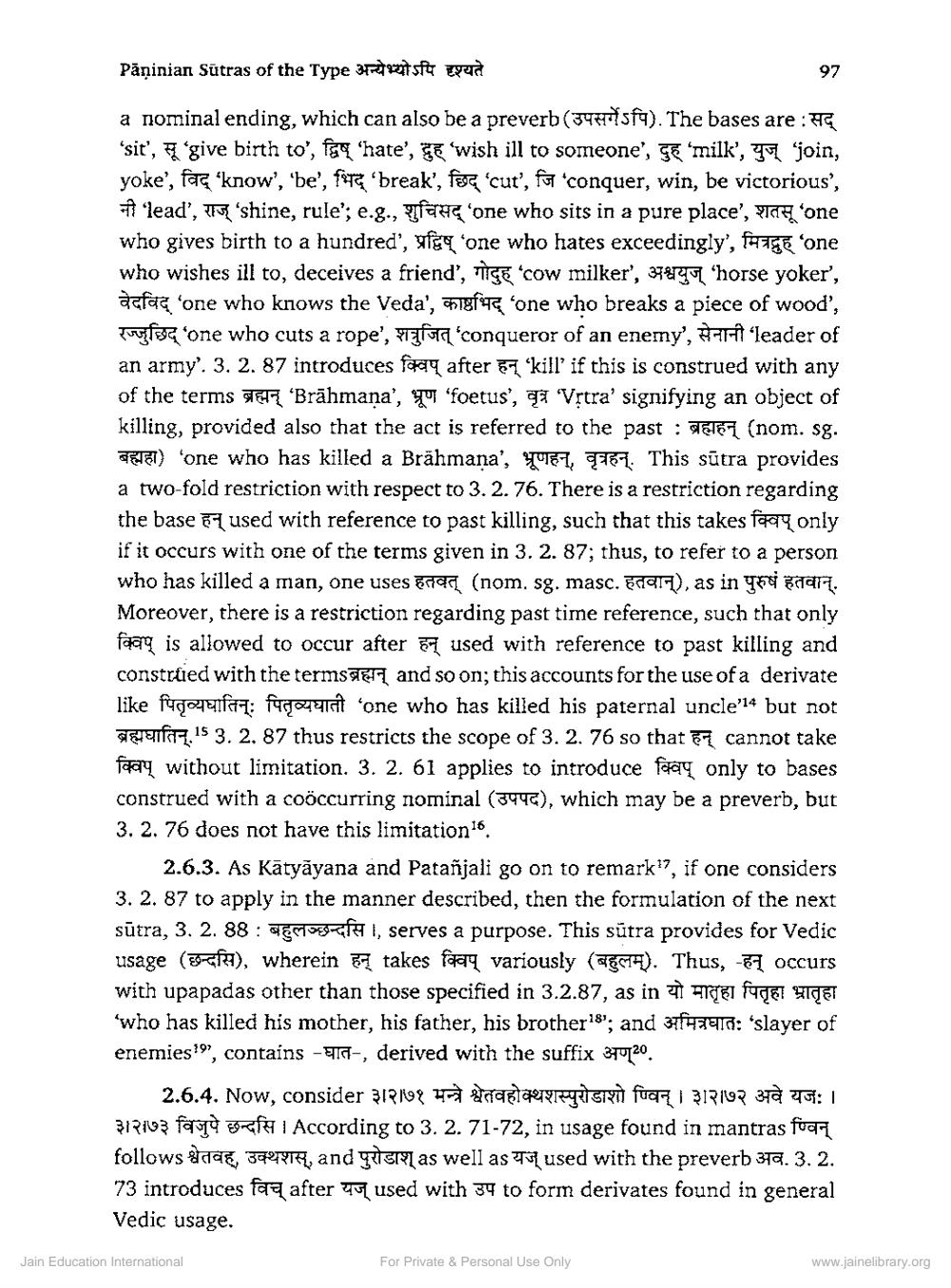________________
Paninian Sutras of the Type अन्येभ्योऽपि दृश्यते
97
a nominal ending, which can also be a preverb(347075f9). The bases are : 'sit', give birth to', fac 'hate', i 'wish ill to someone', e 'milk, F join, yoke', farç 'know', 'be', fire 'break', Fesc'cut', for 'conquer, win, be victorious', नी 'lead', राज् 'shine, rule'; e.g., शुचिसद् 'one who sits in a pure place', शतसू 'one who gives birth to a hundred', wigy one who hates exceedingly', one who wishes ill to, deceives a friend', GE cow milker', 37847 horse yoker', asfaç 'one who knows the Veda', $18fte ‘one who breaks a piece of wood, रज्जुछिद् 'one who cuts a rope', शत्रुजित् 'conqueror of an enemy', सेनानी leader of an army'. 3. 2. 87 introduces feay after 57 kill' if this is construed with any of the terms 16 'Brāhmana', u'foetus', Vstra' signifying an object of killing, provided also that the act is referred to the past : 16167 (nom. sg. बह्महा) 'one who has killed a Brahmana', भ्रूणहन्, वृत्रहन्. This sutra provides a two-fold restriction with respect to 3. 2. 76. There is a restriction regarding the base 5 used with reference to past killing, such that this takes foay only if it occurs with one of the terms given in 3. 2. 87, thus, to refer to a person who has killed a man, one uses हतवत् (nom. sg. masc. हतवान्), as in पुरुषं हतवान्. Moreover, there is a restriction regarding past time reference, such that only forang is allowed to occur after 6 used with reference to past killing and construed with the terms aut and so on; this accounts for the use of a derivate like पितृव्यघातिनः पितृव्यघाती 'one who has killed his paternal uncle'14 but not TELEIF.15 3. 2.87 thus restricts the scope of 3. 2. 76 so that cannot take Terary without limitation. 3. 2. 61 applies to introduce toay only to bases construed with a coöccurring nominal (3446), which may be a preverb, but 3. 2. 76 does not have this limitation 16.
2.6.3. As Kātyāyana and Patañjali go on to remark, if one considers 3. 2. 87 to apply in the manner described, then the formulation of the next sūtra, 3. 2. 88: 570ESGH I, serves a purpose. This sūtra provides for Vedic usage (छन्दसि), wherein हन् takes क्विप् variously (बहुलम्). Thus, -हन् occurs with upapadas other than those specified in 3.2.87, as in ATTEI FUTET ATLET 'who has killed his mother, his father, his brother 18'; and 374016: 'slayer of enemies!", contains - E1G-, derived with the suffix 370720.
2.6.4. Now, consider 312108 HEPTARIR fuck / 3171092 31 TG: BIR103 foto Eraf According to 3. 2. 71-72, in usage found in mantras fuori follows श्वेतवह, उक्थशस्, and पुरोडाश् as well as यज् used with the preverb अव. 3. 2. 73 introduces farq after 4 used with 34 to form derivates found in general Vedic usage.
Jain Education International
For Private & Personal Use Only
www.jainelibrary.org




